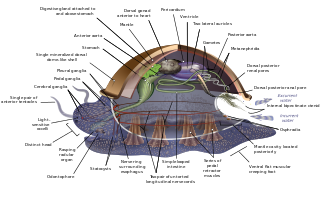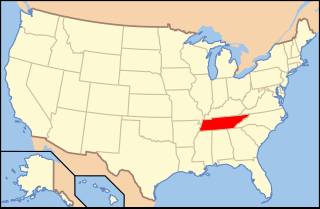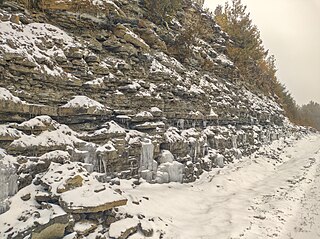
Conodonts are an extinct group of eel-looking agnathan (jawless) vertebrates, classified in the class Conodonta. For many years, they were known only from fossils of their spiky oral elements, which are usually found in isolation and are now called conodont elements, while knowledge about soft tissues remains limited. A resilient group of prehistoric fish, conodonts existed in the world's oceans for over 300 million years, from the Cambrian to the beginning of the Jurassic. Due to their cosmopolitan distribution, conodont elements are widely used as index fossils, fossils used to define and identify geological periods.

The evolution of the molluscs is the way in which the Mollusca, one of the largest groups of invertebrate animals, evolved. This phylum includes gastropods, bivalves, scaphopods, cephalopods, and several other groups. The fossil record of mollusks is relatively complete, and they are well represented in most fossil-bearing marine strata. Very early organisms which have dubiously been compared to molluscs include Kimberella and Odontogriphus.
Cameroceras is an extinct genus of endocerid cephalopod which lived in equatorial oceans during the entire Ordovician period. Like other endocerids, it was an orthocone, meaning that its shell was fairly straight and pointed. It was particularly abundant and widespread in the Late Ordovician, inhabiting the shallow tropical seas in and around Laurentia, Baltica and Siberia.
The Ellesmerocerida is an order of primitive cephalopods belonging to the subclass Nautiloidea with a widespread distribution that lived during the Late Cambrian and Ordovician.
Mcqueenoceras is an extinct genus of early endocerid, a nautiloid from the Floian epoch of the late early Ordovician period. It was similar in overall form to Clitendoceras, from which it may have been derived. Mcqueenoceras, like Clitendoceras, has ventral siphuncle but the endocones are thicker on the ventral side and thinner on the dorsal. Also the sutures in Mcqueenoceras retreat rearward, forming lobes as they cross the venter. The type species is Mcqueenoceras jeffersonense, named by E.O. Ulrich and A.F. Foerste in 1935, and it is known from Missouri and New York. In 1956, Rousseau H. Flower named two other species, M. cariniferum and M. ventrale, both known from Maryland.

Scenella is an extinct genus of fossil invertebrate animal which is generally considered to be a mollusc; at various times it has been suggested that this genus belongs with the gastropods, the monoplacophorans, or the helcionellids, although no firm association with any of these classes has been established. An affinity with the hydrozoa has been considered, although some authors oppose this hypothesis. A gastropod affinity is defended on the basis of six pairs of internal muscle scars, whilst the serially-repeated nature of these scars suggests to other authors a monoplacophoran affinity. However the specimens showing this scarring have not been convincingly shown to belong to the genus Scenella. A similarity to the Ediacaran Ovatoscutum has also been drawn.

The extinct Solenoporaceae have traditionally been interpreted as a group of red algae ancestral to the Corallinales.

Eldonia is an extinct soft-bodied cambroernid animal of unknown affinity, best known from the Fossil Ridge outcrops of the Burgess Shale, particularly in the 'Great Eldonia layer' in the Walcott Quarry. In addition to the 550 collected by Walcott, 224 specimens of Eldonia are known from the Greater Phyllopod bed, where they comprise 0.43% of the community. Species also occur in the Chengjiang biota, Siberia, and in Upper Ordovician strata of Morocco.
The Kirengellids are a group of problematic Cambrian fossil shells of marine organisms. The shells bear a number of paired muscle scars on the inner surface of the valve.
A trab is a structural element within a sponge formed by the fusion of dendroclones.

Halichondrites, sometimes mis-spelt Halicondrites is an extinct genus of sea sponge known from the Middle Cambrian Burgess Shale. 7 specimens of Halichondrites are known from the Greater Phyllopod bed, where they comprise < 0.1% of the community.

Sphenothallus is a problematic extinct genus lately attributed to the conulariids. It was widespread in shallow marine environments during the Paleozoic.

Archeognathus is a fossilized jaw apparatus of a large predatory conodont from the Ordovician period. Its large size has made classification difficult, and it has historically been compared to conodonts and gnathostomes since its remains were first discovered in Missouri. Complete articulated jaw apparatus of Archeognathus primus are common in the Winneshiek Shale lagerstätte of Iowa, allowing its identity as a conodont to be secured.
Palaeoaplysina is a genus of tabular, calcified fossils that are a component of many Late Palaeozoic reefs. The fossil acted as a baffle to trap sediment. Historically interpreted as a sponge or hydrozoan, recent studies are converging to its classification in the coralline stem group, placing it among the red algae.

Paleontology in Tennessee refers to paleontological research occurring within or conducted by people from the U.S. state of Tennessee. During the early part of the Paleozoic era, Tennessee was covered by a warm, shallow sea. This sea was home to brachiopods, bryozoans, cephalopods, corals, and trilobites. Tennessee is one of the best sources of Early Devonian fossils in North America. During the mid-to-late Carboniferous, the state became a swampy environment, home to a rich variety of plants including ferns and scale trees. A gap in the local rock record spans from the Permian through the Jurassic. During the Cretaceous, the western part of the state was submerged by seawater. The local waters were home to more fossil gastropods than are known from anywhere else in the world. Mosasaurs and sea turtles also inhabited these waters. On land the state was home to dinosaurs. Western Tennessee was still under the sea during the early part of the Cenozoic. Terrestrial portions of the state were swampy. Climate cooled until the Ice Age, when the state was home to Camelops, horses, mammoths, mastodons, and giant ground sloths. The local Yuchi people told myths of giant lizard monsters that may have been inspired by fossils either local or encountered elsewhere. In 1920, after local fossils became a subject of formal scientific study, a significant discovery of a variety of Pleistocene creatures was made near Nashville. The Cretaceous bivalve Pterotrigonia thoracica is the Tennessee state fossil.

Paleontology in Oklahoma refers to paleontological research occurring within or conducted by people from the U.S. state of Oklahoma. Oklahoma has a rich fossil record spanning all three eras of the Phanerozoic Eon. Oklahoma is the best source of Pennsylvanian fossils in the United States due to having an exceptionally complete geologic record of the epoch. From the Cambrian to the Devonian, all of Oklahoma was covered by a sea that would come to be home to creatures like brachiopods, bryozoans, graptolites and trilobites. During the Carboniferous, an expanse of coastal deltaic swamps formed in areas of the state where early tetrapods would leave behind footprints that would later fossilize. The sea withdrew altogether during the Permian period. Oklahoma was home a variety of insects as well as early amphibians and reptiles. Oklahoma stayed dry for most of the Mesozoic. During the Late Triassic, carnivorous dinosaurs left behind footprints that would later fossilize. During the Cretaceous, however, the state was mostly covered by the Western Interior Seaway, which was home to huge ammonites and other marine invertebrates. During the Cenozoic, Oklahoma became home to creatures like bison, camels, creodonts, and horses. During the Ice Age, the state was home to mammoths and mastodons. Local Native Americans are known to have used fossils for medicinal purposes. The Jurassic dinosaur Saurophaganax maximus is the Oklahoma state fossil.

The Verulam Formation is a geologic formation and Lagerstätte in Ontario, Canada. It preserves fossils dating back to the Katian stage of the Ordovician period, or Shermanian to Chatfieldian in the regional stratigraphy.
Appalachignathus is a genus of multielement conodonts from the Middle Ordovician of North America.

Calathium is an extinct genus of organism found in marine beds of Ordovician age. Its classification is enigmatic: It has long been placed among the receptaculites, but it has also been described as a quasi-sponge, possibly akin to the archeocyathids or other hypercalcified sponge. The chief difference from archaeocyathids is that their walls were connected by rods rather than septae.











